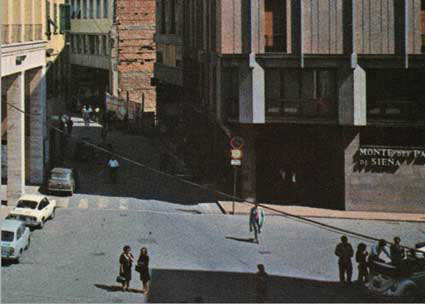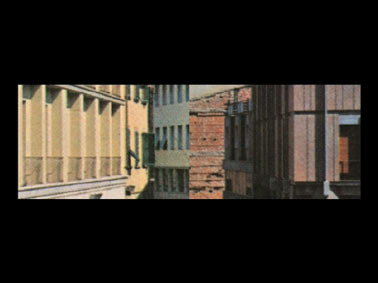| AUSSTELLUNG | EVENTS | KÜNSTLER | HOME |
Medienkunst aus Berlin
Video, Performance, Installationen, Dokumentationen, Musik, Multimedia,
Interaktion, Stills und Objekte aus den ersten 6 Jahren des 3. Jahrtausends.
Anna Anders, Dietmar Arnold, Jovan Balov, Sandra Becker, Ana Bilankov, Noam Braslavsky, Michael Brynntrup, Daniela Butsch, Genia Chef, Heiko Daxl, Claus Feldmann, Hanna Frenzel, Ingeborg Fülepp, Steven Gagnon, Archi Galentz, Monika Funke, Margita Haberland, Gab Heller, Sanja Ivekovic, Franz John, Kain Karawahn, Susanne Kienbaum, Betina Kuntzsch,Ilka Lauchstädt, Walter Lenertz, Antal Lux, Benoit Maubrey, Bettina Munk, Mona Mur, Sven Holly Nullmeyer, Günther Petzold, Claudius Pratsch, Klaus Riech, Susken Rosenthal, Ilse Ruppert, Mariko Sakamoto, Joachim Seinfeld, Lisa Schmitz, Ira Schneider, Jan-Peter E. R. Sonntag, Thorsten Streichardt, Signe Theill, Clea T. Waite, Eku Wand, Ute Weiss-Leder, André Werner
Jan-Peter E. R. Sonntag
BOWLING (That Bowling Alley on the Tiber) 2003/2005
 |
 |
|---|
The starting point of the installations are Italian postcards showing housing estates of the 1960s, chansons by the Italian singer Mina, recorded in the same decade, and texts by Michelangelo Antonioni ? sketches for films never made. The postcards were scanned and, by electronic processing, transformed into a virtual film set, an artificial space, in which a virtual camera can move. According to the emotionally drastic development of the digitally processed songs by Mina, they are cinematically dissolved (clips, camera work, cut, editing) up to apparently narrative film sequences, only without protagonists, since there are no people in the postcards. The banality and partial dullness of the housing estates is set in contrast to the clichés in the emotional and yearning songs. Using only sound and deserted pictures, the installation tells a seemingly emotional story. The actors have an emotional relationship with each other through their physical presence. Their texts describe rooms, places, and the people in these places; they are texts by Michelangelo Antonioni, beginnings of possible films but always starting with the description of a room or place. The soundscape acoustically accomplishes the deserted film clips of the postcards, i. e., we hear the noise of invisible people. 30 years later Sonntag and Carp went to Arezzo to find the original places of the visual shots. There we rekorded the soundtrack. ?Bowling am Tiber? deals with the emotional content of places, buildings, rooms and the relationship between human beings and space; with Antonioni it always leads to the feeling of loneliness. Due to the exstremly high resolution it is possible to zoom right into the grain pattern of the offset printing - ornamental surfaces - and further on into the digital pixel structure without any intergradations. Abstract colour spaces develope out of at first apparently semantically concrete visual material. Parallel we work with an extreme slowdown of the sound material - some kind of acoustic interpolation letting the cinematic / musical dramatugies freeze as "abstract" acoustic as well as light/colour spaces. Spaces emerge that are open for the projection of the feelings developed in the cinematic narration. The close-up zooming through the subject-matter is congealed in the overexpansion of sound into standstil, thus becoming "devoid time"; an overexpanded in-between of narrated time. Concept: Peter Carp / Jan-Peter E.R. Sonntag 3 Channel highsolution digital video / doublescreen frontprojection (2 x 5m x 3,50m) one screen backprojection (3m x 2,3m) 2 channel digital sound Video Direction/Composition: Carp / Sonntag Space/Installation: Jan-Peter E.R. Sonntag Direction on stage: Peter Carp Videoprograming: Thomas Ploentzke Visual footage: 6 Postcards from Arezzo (60'th) Music/Soundscape: Jan-Peter E.R. Sonntag Tenortrombone&Basstrombones: Marsyas Doublebass: Andre Neygenfind Guitar: Harry Kügler Drums: Oliver Sonntag Electronics&Production: Sonntag All Soundscapes were recorded in june 2003 in Arezzo at the original places. Samples out of songs from MINA (`65-`69) Studios: N-Solab (Berlin), Musikplant (Lübeck) Texts from Michelangelo Antonioni Production: Carp / Sonntag 2003/2005 Coproduktion: steirrischer herbst (Graz), hARTware-Projekte (Dortmund), Gare du Nord (Basel) supportet by the Kulturstiftung des Bundes and the TMA (Dresden) Stageproduction: THEATER LUZERN 2005 |
|---|
CV 1965 in Lübeck geboren, lebt und arbeitet in Berlin, Oldenburg und Barcelona. 1982 Studium der Komposition an der Musikhochschule Lübeck 1986 Studium der Bildenden Kunst, Kunstwissenschaft und Philosophie an der Universität Oldenburg. Seit 1979 arbeitet der Künstler mit experimentellen Klangperformances und Installationen, vor allem mit Licht, Druckwellen, Video und Mixed Media. Seine Installationen sind genreübergreifend und loten vor allem die Grenzbereiche menschlicher Wahrnehmung aus. Seit 1989 hat er mobile “Instrumentarien” entwickelt, mit denen er dem vorgefundenen Ausstellungsraum durch optische und akustische Setzungen eine skulpturale Definition gibt. Ausstellungen: 2002 “N-Spiral-chromosomen”, Galerie chromosomen, Berlin; 2000 CYNET ART FESTIVAL, Kunsthalle Dresden; modern-minimal disco 6”, Zeppelin Sound Art Festival; “Abenteuer in Sachen”, Theatre National Luxembourg, Luxemburg; 2000 “ratio agendi 2”, Staatsgalerie Stuttgart; “Dystopia 2”, Akademie der Künste Berlin; BODSON2, Akademie Schloss Solitude; “Déjeuner sur l’herbe 4”, METRONOM, Fundaci-Rafael Tuls d’Art Contemporant, Barcelona; 1999 “ Afinidades dipersas”, “The Yellow Cell”, Museum der Fundacion Arte & Technologia , Madrid; 1998 Apex Art C.P. Gallery New York; 1997 “Oktober 1917”, Norwich Gallery, Norwich; 1996 “un-friede”, “sabotage von wirklichkeiten”, Kunstverein and Künstlerhaus Hamburg1995 “modern minimal disco”, making waves festival 95, United Nations San Francisco; 1994 raum - Arbeit #18 - PLAZA, 220 V Soundpark, Sculpure Park Rotterdam. |
|---|